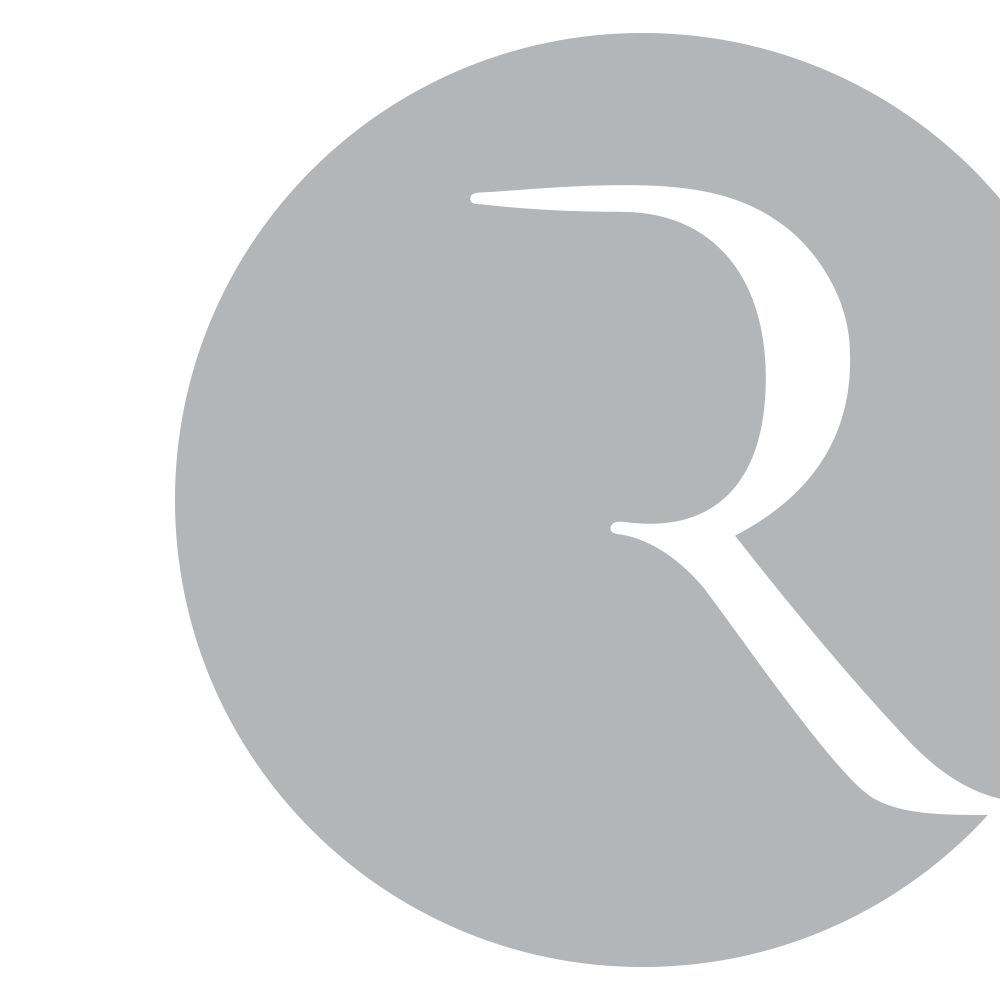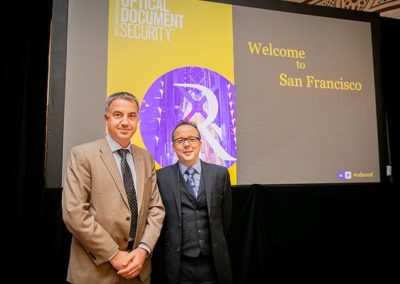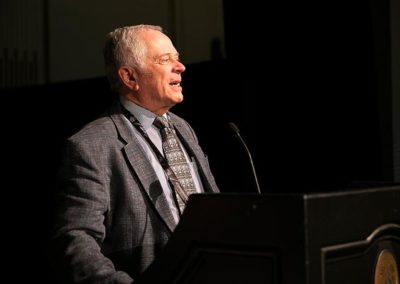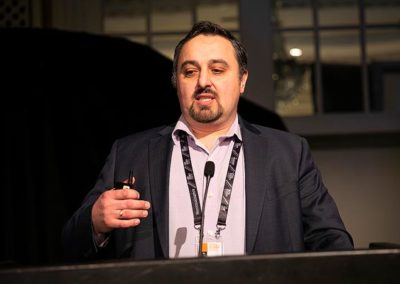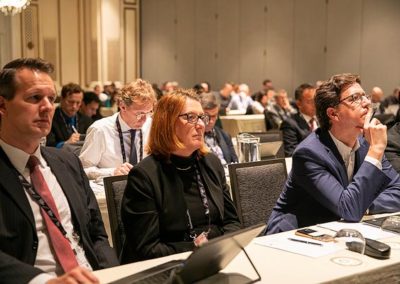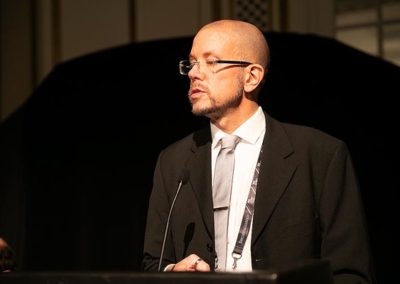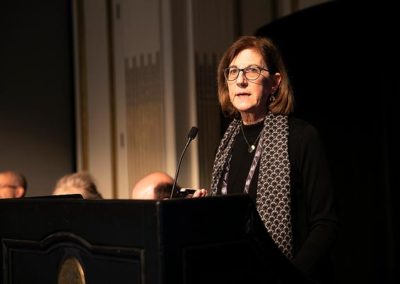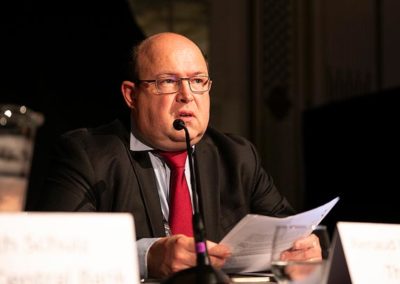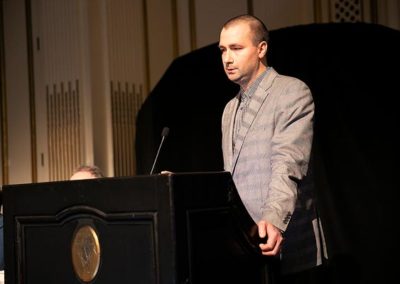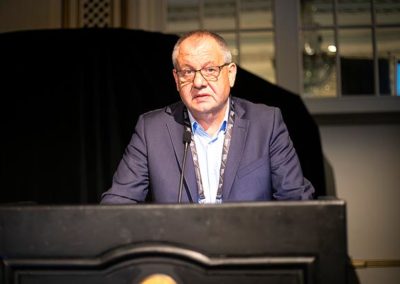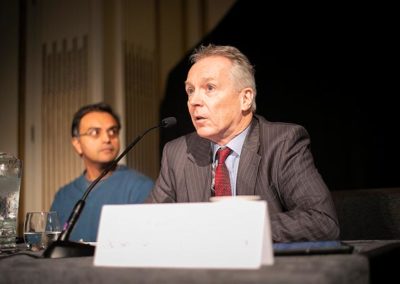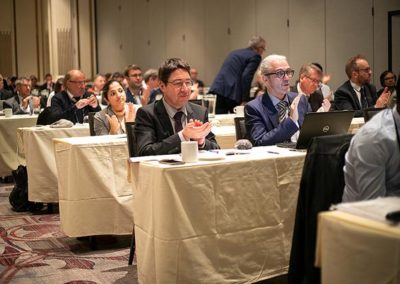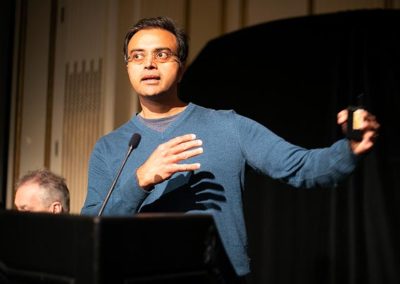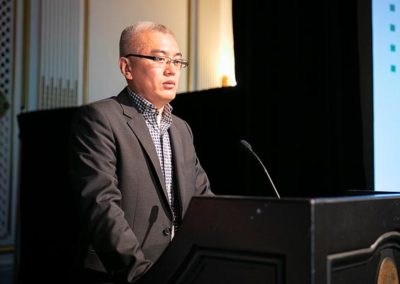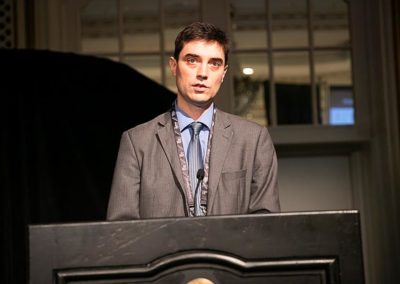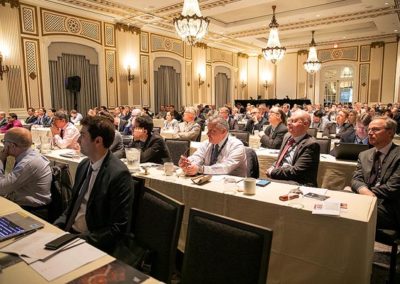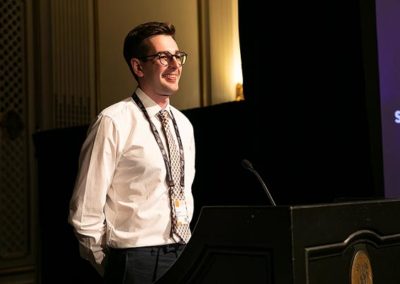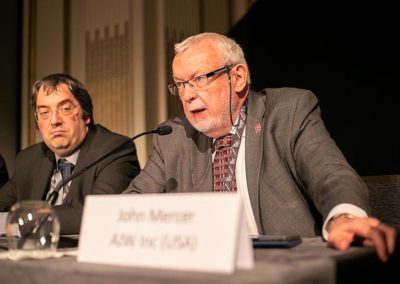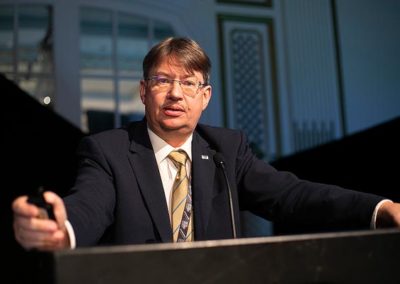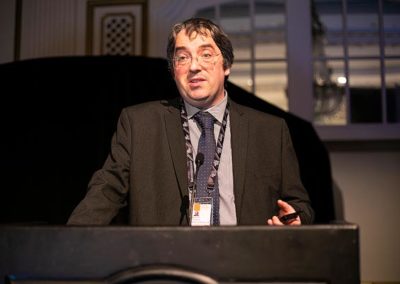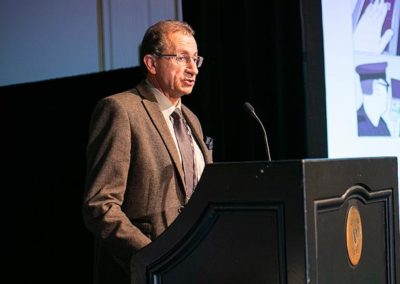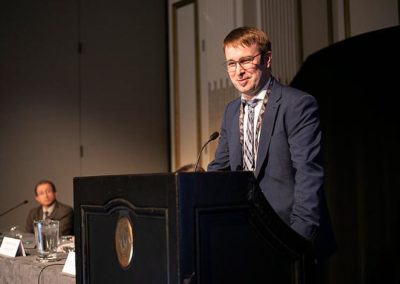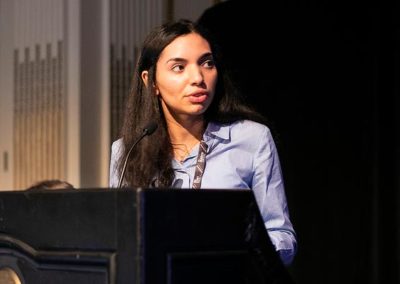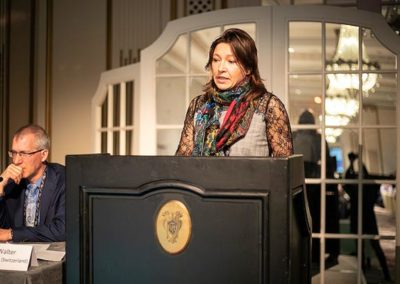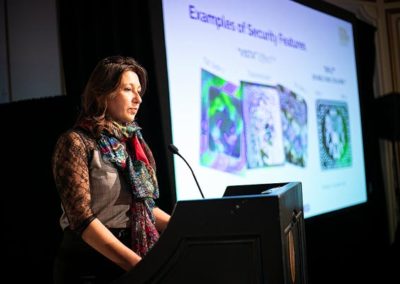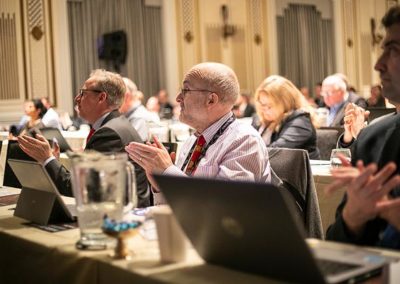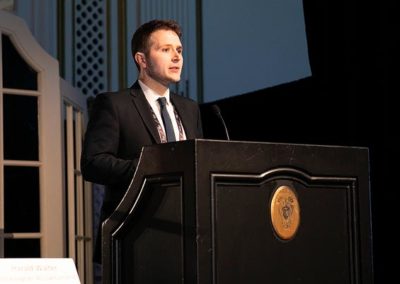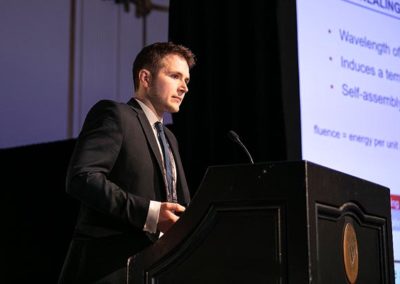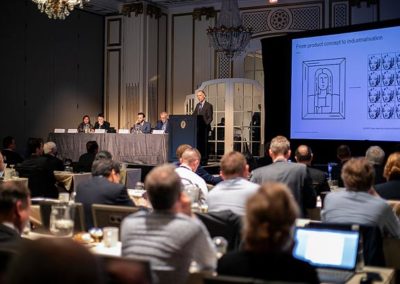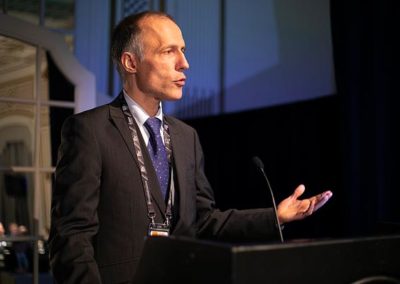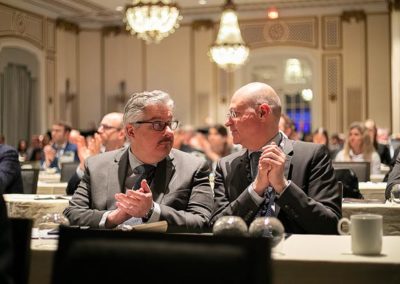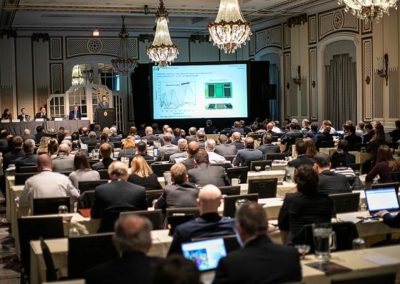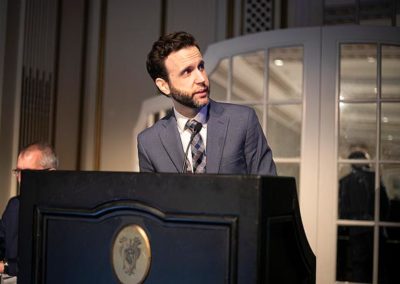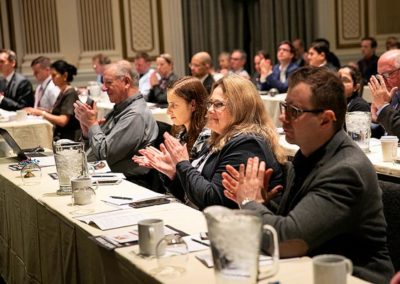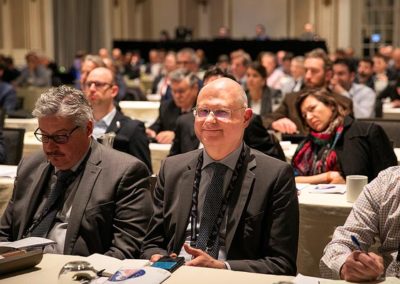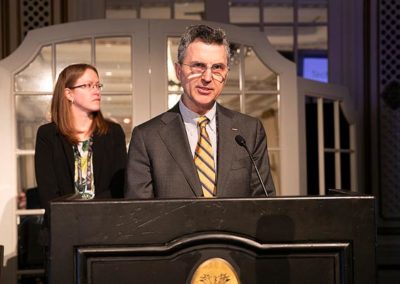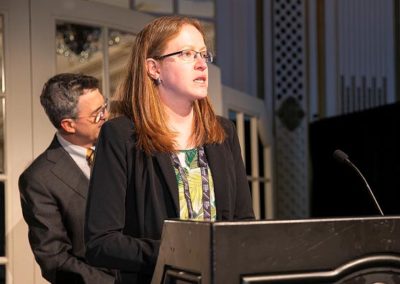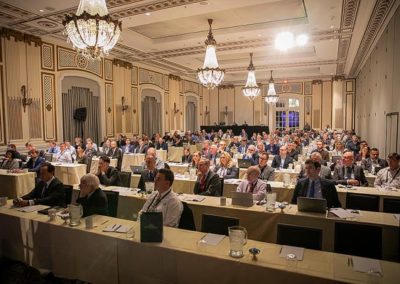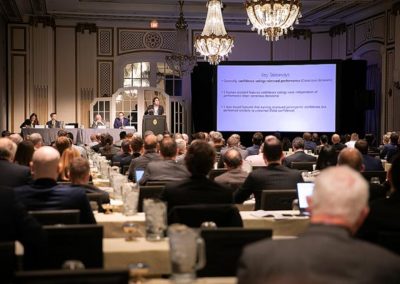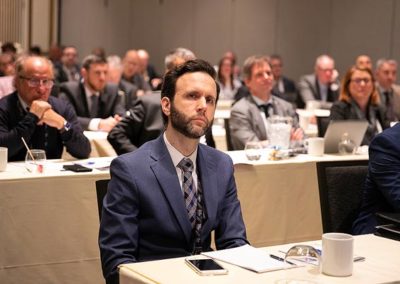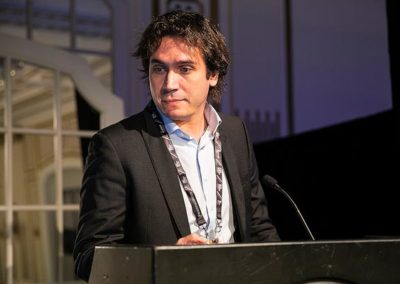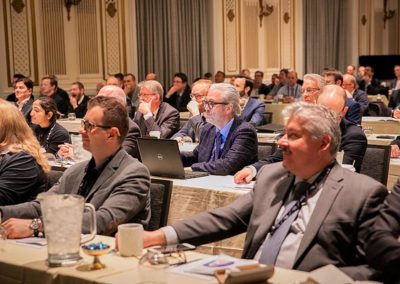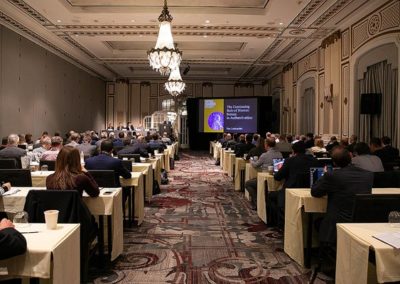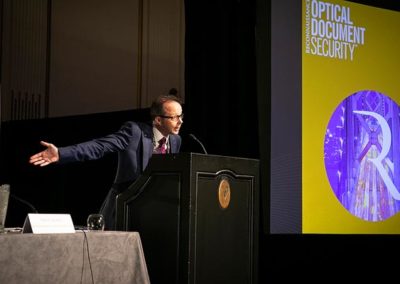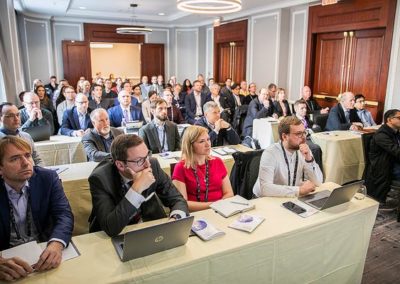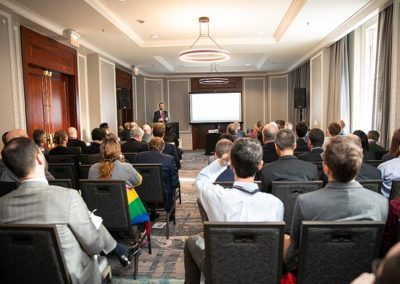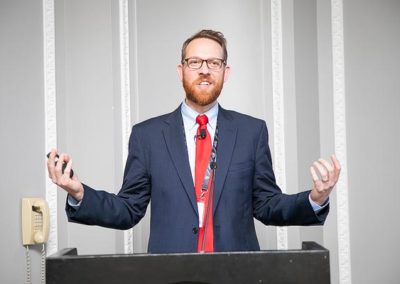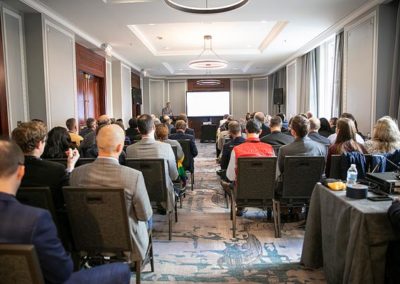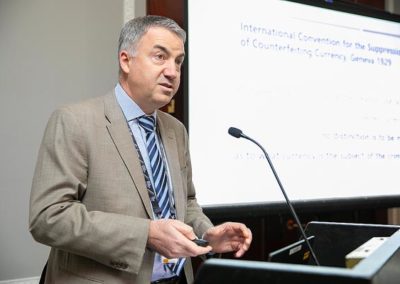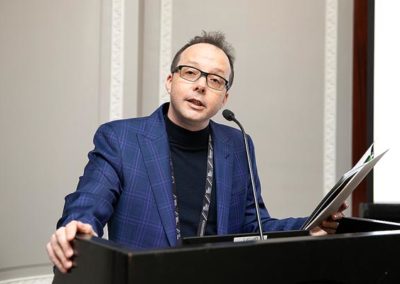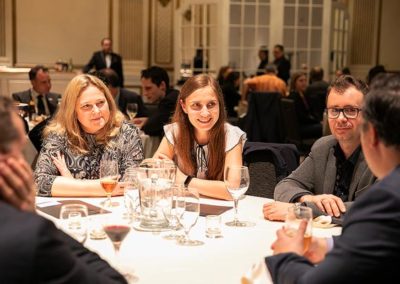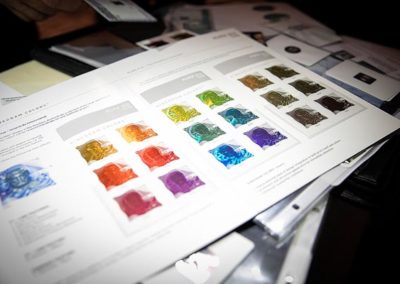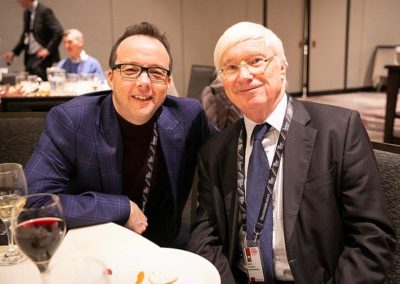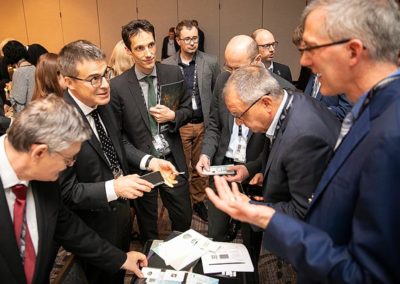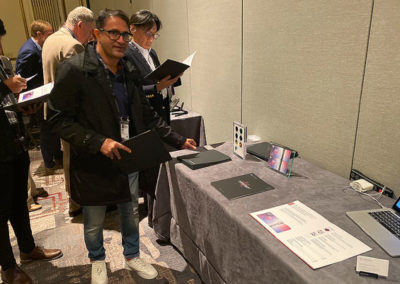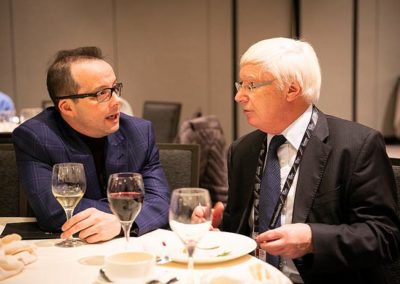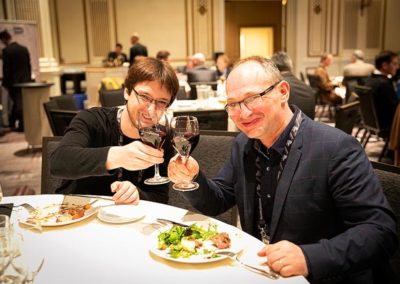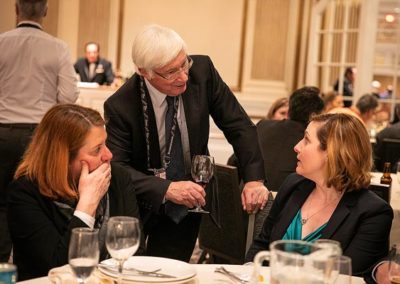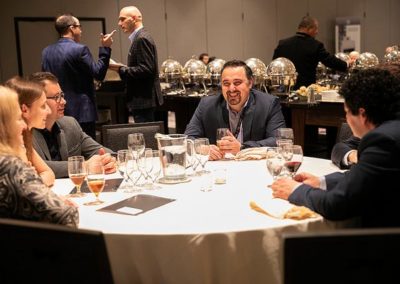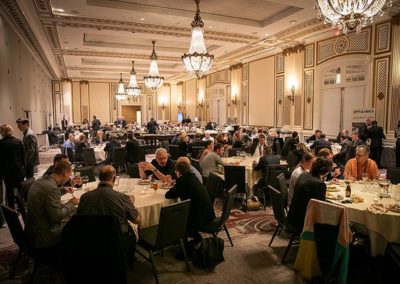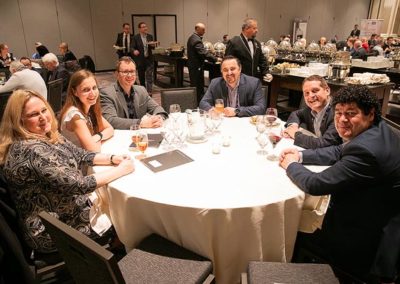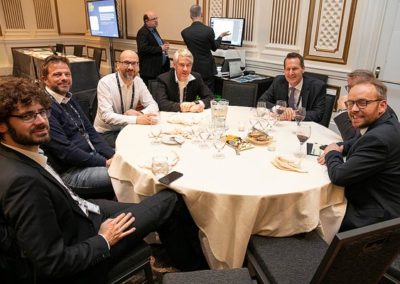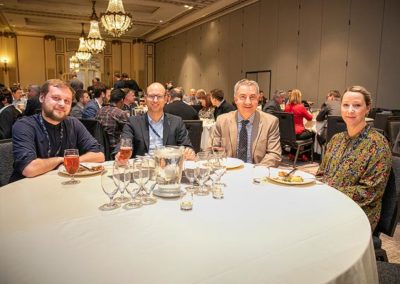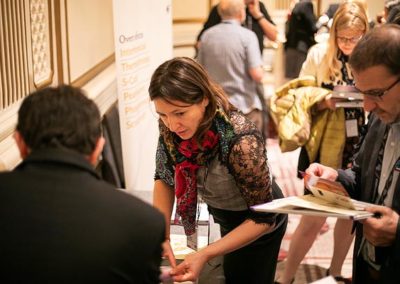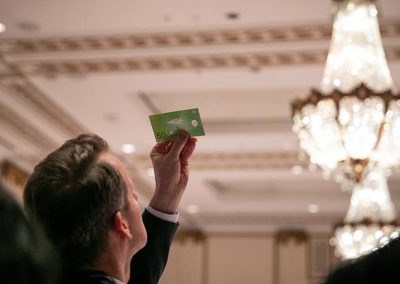Attendee's Location
Thank you to our Table Top Exhibitors






ODS 2020 Review
Conference Review
The Optical Document Security (ODS) Conference, which took place in San Francisco from January 29-31 attracted 168 delegates from 24 countries and 114 different organisations with 7 table-top displays in the exhibition.
The conference was preceded by a joint morning session with Electronic Imaging’s Media Watermarking, Security & Forensic Conference and an afternoon short course on the new topic ‘The Detection and Techniques of Banknote and ID Counterfeiting’ presented by Interpol and the US Department of Homeland Security.
The ODS conference is specifically about optical science related to the security of documents. It is the forum where embryo technologies or technologies recently conceived or in their infancy are introduced, to be critically appraised by a technically-focused audience from government bodies, institutions or commercial organisations involved in secure documents. The hope of the presenters and delegates alike is that ‘next generation’ security technologies will emerge from the conference.
Technology updates
The conference also allows the industry to follow those technologies that develop past the concept stage though infancy to maturity, always focussing on the science behind the developments. Thus, some of the papers or exhibition displays feature technologies which were introduced at a previous conference – such updates can be as relevant and informative as new technologies. For example, at 2018’s ODS conference Luke Maguire of the Reserve Bank of Australia introduced caustic surfaces to produce projection images that can be authenticated using a smartphone. This was augmented at this year’s ODS with a paper from Sicpa’s Andrea Callegari on ‘Caustic-based Optical Security in the Banknote context’.
Surys (formerly Hologram Industries) introduced Plasmon technology at ODS in 2012 (Extraordinary transmission for an effective see-through DOVID). Two years later at ODS 2014, Surys presented ‘Plasmon Science for a Novel Metallic Glance with a Dramatic and Azimuthal Colour Shift’.
Whilst in 2016 Surys combined transmission and reflection with the introduction of the Plasmogram™. At this year’s ODS, Surys presented their Plasmogram optimised Reverso Product that incorporates optimised hybrid metal dielectric structures that present different reflective colours on the front and back of a polymer banknote, and a different colour in transmission whilst also each combining an angular colour shift.
Day one: human factors, novel materials and production
A wide range of technologies conveniently grouped into five sessions of similar topics were covered over two days. The first day of the conference opened with a session dedicated to Human Factors and Design, and a thought provoking keynote speech from conference chairman Ian Lancaster on ‘The Continuing Role of Human Senses in Authentication’ which emphasised that we should value the contribution of human senses in document authentication and educate the digital developers to recognise this value. This was followed by a paper on ‘Lab-based Perception Studies on Whole Notes’ from the Bank of Canada which including gaze tracking, and a final session paper from the US Bureau of Engraving and Printing which concluded that security feature technologies are maturing and diffusing at a rapid rate and that intaglio printing has become an effective deterrence to counterfeiting.
Session two focussed on Novel Materials and included a total of seven papers, showing the high level of invention and innovation in this field. The session began with a paper from Polytechnique Montréal introducing active electrochromic materials for potential use in transparent windows on banknotes and other important documents. This was followed by a presentation on Caustic based Optical Security for Banknotes from Sicpa, and a fascinating paper on ‘Laser-Nanostructuring of Plasmonic Nanoparticles’ from Opsec and Nottingham Trent University. The latter paper outlined how it is possible to control plasmonic nanoparticles using lasers to produce overt localised surface plasmon resonance colour switch effects that could be used for transparent window features.
A new photoactive embossable ink that produces optical security features was the theme in a paper from Annalisa Colombo from EPTAINKS. This was followed by the Surys paper presented by Soukainan Es-Saidi on the latest Plasmogram Reverso product as previously outlined, prior to two papers from OVD Kinegram on: ‘Achromatic and Monochromatic Effects based on Non-Holographic Microstructures’ which outlined diffractive watermark and circle movement effects together with directional white microstructures, and a paper by John Peters on ‘Transforming DOVIDS for the Digital World’ which concluded that DOVIDS need to be designed for both human and machine verification and that physical ID’s will remain the reliable root of trust for the future.
Production was the topic of the final session of day one and opened with a paper form KBA NotaSys on ‘Micro-Optic Noise: Causes, Quantification and Solutions’. The paper concluded noise in micro-optics results from three main areas : design, configuration and manufacture, with configuration being the easiest to quantify. This was followed by a joint paper from inIT-Institute Industrial IT and KBA NotaSys on ‘Intaglio Style Transfer – Partially Automating the Intaglio Image Creation’ that utilised Convolutional Neural Networks to encode RGB (red, green,and blue) and greyscale images to synthesise intaglio images. Mary Kombolias from the US Government Publishing Office and National Institute of Standards and Technology then presented a paper on ‘Resonant Cavity Dielectric Spectroscopy for Quality assurance Evaluations of Secure Documents’ which proved that the technique can be used to provide information on composition (fiber types and colorants), and the relative age for printing and writing grades of paper. The last paper of day one was presented by Elisabeth Limbacher from Orell Füssli on ‘Market Developments: When Technology meets Artisanship’.
Day two : smartphones, examination and authentication
Day two began with a session on Optical Security Interaction with Smartphones and included six papers. Charles Gale from Pulsetech Security opened the session with a paper titled ‘A multi-layer Denisyuk Hologram for Authentication by Smartphone’ which outlined a new type of photopolymer authentication security marker that can incorporate multiple data sets and be read by a smartphone. Following on was a paper from CSEM on ‘Transparent DOVIDs Optimised for Readability With any Smartphone’ which built on CSEM’s paper presented at ODS 2018, and highlighted that high transparency / invisible security DOVIDS can be produced, and read with a smartphone operating system without the need to develop a dedicated app. This was followed by a paper from Fraunhofer SIT on ‘Securing Physical Documents with Digital Signatures’ that outlined a fingerprint technology that utilises public key infrastructure (PKI) and an eight colour machine readable JAB Code that can be read offline.
Paper four from the University of Utah and Oblate Optics focussed on ‘Ultra-flat Micro- and Nano-Optical Security Features’ and presented a new completely flat micro-lens that is up to 5 times thinner and cheaper to manufacture than conventional hemispherical micro-lenses. This was followed by the penultimate paper of the session presented by Zhicheng Ye on ‘Flexibly Tuneable Smartphone Recognisable Plasmonic Colours’ from China’s Shanghai Jiao Tong University. The paper outlined how the intrinsic polarisation character of plasmonic structural colours can be utilised to produce plasmonic tags that can be read by a smartphone. The final smartphone session paper from Bulgarian based Demax on ‘Nano-optical Variable Device for Easy Recognition and Smartphone Verification’ outlined the development of an electron beam originated security device that can incorporate a unique nano-optical high security code that can be read by a smartphone without the use of additional equipment attached to the smartphone.
The last session of the conference was dedicated to Examination and Authentication and included five papers. Elisabeth Schulz from the European Central Bank opened the session with a paper on ‘Emulated Security Holograms on Euro Banknotes – A Technology’ which outlined the holograms of the Europa series have not been successfully attacked. This was followed by a paper from the University of Birmingham (UK) on ‘3D Micro-Optics Enable Fast Banknote Authentication by Non-expert Users’ which reported on a perception study on Crane Currency’s 3D micro-optic Motion Surface security feature. The study concluded that 3D signals are rapidly available to the brain (within 100 milliseconds) and are rapidly processed even under very low light levels.
‘High-entropy Multi-dimensional OVD Characterisation Facilitating Multimodal Authentication’ was presented by Swedish based gonioLabs and concluded that high-entropy OVD characterisation facilitates authentication. The penultimate paper from Regula on ‘Analysis of Currency and Documents with Counterfeit OVIDS’ built on the presentation delivered at ODS 2016 on the Regular 2303.01 desktop reader. This latest presentation analysed a series of counterfeit currency holograms using the desktop reader and was able to detect the counterfeits holograms with a high probability and quantitatively.
The final paper of the conference was presented by Volker Lohweg from the InIT-Institute Industrial IT on ‘Creating a Self-Authentication System for Smart Banknotes’. This fascinating paper outlined the definition of a smart banknote and the use of chemicals, in this case spiropyrans, to act as a clock in a banknote life cycle to assist as a memory or ageing marker.
OpSec Security Group
Alan Hodgson Consulting
USGPO/NIST
Statni Tiskarna Cenin
Saint Gobain Corporation
JDLZ Consulting
Attendees
AIT Austrian Institute of Technology GmbH
Austria
AJW Inc
USA
Alan Hodgson Consulting
United Kingdom
Angstrom Technologies, Inc.
USA
ANY Security Printing Company PLC
Hungary
Authentix Inc
USA
Banco de España
Spain
Bank of Canada
Canada
BASF Corporation
USA
BASF SE
Germany
Bundesdruckerei GmbH
Germany
Bundeskriminalamt Wiesbaden
Germany
Canadian Bank Note Company Ltd
Canada
Centro Grafico DG S.p.A
Italy
collIDe
USA
Crane Currency
USA
Crane Payment Innovations
USA
Crime Science Technology
France
CSEM SA Basel
Switzerland
Cummins-Allison Corporation
USA
Customs and Border Protection (CBP)
USA
Danmarks Nationalbank
Denmark
De La Rue
United Kingdom
De Montfort University
United Kingdom
Defence Science & Technology Laboratory (DSTL)
United Kingdom
DEMAX Holograms Plc
Bulgaria
Eastman Kodak Company
USA
Ecole Polytechnique de Montreal
Canada
EPTAINKS S.P.A
Italy
European Border and Coast Guard Agency (Frontex)
Poland
European Central Bank
Germany
Exponent Inc.
USA
Federal Reserve Bank of Richmond
USA
Federal Reserve Board of Governors
USA
Foster & Freeman USA
USA
Fraunhofer SIT
Germany
Giesecke+Devrient Currency Technology GmbH
Germany
Gleitsmann Security Inks GmbH
Germany
gonioLabs AB
Sweden
Heidelberg Instruments Mikrotechnik GmbH
Germany
HID Global
USA
Hologramas de Mexico (HOLOMEX)
Mexico
Hueck Folien GmbH
Austria
IAI industrial systems B.V.
Netherlands
inIT – Institute Industrial IT
Germany
Innovative Technology Ltd
United Kingdom
Inovink Ltd
United Kingdom
Interpol
France
JDLZ Consulting
Israel
JSC RPC Krypten
Russia
KBA-NotaSys SA
Switzerland
Landqart AG
Switzerland
Lawrence Livermore National Laboratory
USA
Lazos Internacionales Sa de Cv
Mexico
Leonhard Kurz Stiftung & Co KG
Germany
LK Forensic Competencies
Switzerland
Los Alamos National Laboratory
USA
Luminescence International Ltd
United Kingdom
Nanotech Security Corp
Canada
National Bank of Belgium
Belgium
National Identity Management Commission of Nigeria
Nigeria
National Institute of Standards and Technology
USA
New Light Industries Ltd
USA
Oak Ridge National Laboratory
USA
Oberthur Fiduciaire SAS
France
Oesterreichische Banknoten und Sicherheitsdruck GmbH (OEBS)
Austria
Ohio State University
USA
Onfido
United Kingdom
OpSec Security Group
United Kingdom
Orell Füssli Security Printing Limited
Switzerland
OVD Kinegram AG
Switzerland
Pacific Holographics
USA
Papierfabrik Louisenthal GmbH
Germany
Polish Security Printing Works (PWPW)
Poland
Precision Converting Technologies
USA
Pulsetech Security Limited
United Kingdom
Regula Baltija Ltd
Latvia
Rolic Technologies Ltd.
Switzerland
Rolling Optics AB
Sweden
Saint Gobain Corporation
Schreiner Group GmbH & Co KG
Germany
Sectago GmbH
Germany
SECULYSIS Research institute Inc.
Japan
Security Fibres UK Limited
United Kingdom
Shanghai Jiao Tong University
China
SICPA SA
Switzerland
STA Technologies Inc
USA
Statni Tiskarna Cenin
Czech Republic
SURYS
France
Swiss National Bank
Switzerland
tesa scribos GmbH
Germany
Thales
France
Toppan Printing Co Ltd (Japan)
Japan
Ultra Electronics Forensic Technology Inc.
Canada
UnderCurrency S.A. de C.V.
Mexico
University of Birmingham
United Kingdom
University of Utah
USA
US Bureau of Engraving and Printing
USA
US Department of State
USA
US Department of State – Bureau of Consular Affairs
USA
US Immigration & Customs Enforcement – Virginia
USA
US Secret Service
USA
Viavi Solutions Inc
USA
Wavefront Technology
USA
Yokohama National University
Japan
Foster & Freeman
De La Rue
Landqart AG
Programme
Wednesday 29 January
13:00 – 17:00
The Detection and Techniques of Banknote and ID Counterfeiting
In this innovative Short Course, an expert banknote and an expert identity document examiner will each present an analysis of the optical security features they see on fraudulent banknotes, passports, visas and other ID items.
Course participants will learn and understand about the evolving threat of counterfeit optical security features. They will see how these forensic examiners go about their job of identifying fakes and trying to track their provenance to find the criminals responsible. The Course leaders will show a variety of fake optical features on their document carriers and explain the techniques that have been used to make them. Most importantly, they will give guidance on how to examine optical features in the field as well as in a more controlled environment, showing some of the typical indicators that a feature is fake, altered or fraudulent in some other way..
Thursday 30 January
Hover on the presentation title or speaker to see if more information is available.
Presentation is available for download, click on the icon to access the download page.
Session 1: Human Factors and Design
08:30
Welcome to ODS 2020
Mark Deakes, Conference Director
Reconnaissance International (United Kingdom)
08:40
The Continuing Role of Human Senses in Authentication
Ian Lancaster
Reconnaissance International (United Kingdom)
09:30
Technology Life Cycle for U.S. Currency Security Features
Stephen Surko
Bureau of Engraving and Printing (United States)
Session 2: Novel Materials
11:15
Laser-induced structuring of thin metal films: A method to produce optical security features using surface plasmon resonance
Garry W. Mudd
OpSec Security Ltd & Nottingham Trent University (United Kingdom)
11:40
Selected Photoactive Compounds (PAC) from Microelectronics for Security Docume
Annalisa Colombo
EPTAINKS S.P.A. (Italy)
13:30
From the Physics of Plasmogram Technology to optimized Reverso Product
Soukaina ES-SAIDI
SURYS (France)
13:55
Achromatic and Monochromatic Effects based on a new class of non_holographic asymmetric micro_structures
Sebastian Mader
OVD Kinegram AG (Switzerland)
Session 3: Production
15:15
Micro-Optic Noise: Causes, Quantification and Solutions
Robert Stewart
KBA NotaSys (Switzerland)
15:40
Intaglio Style Transfer – Partially Automating the Intaglio Image Creation
Volker Lohweg
inIT-Institute Industrial IT (Germany)
16:05
Resonant Cavity Dielectric Spectroscopy for QA/QC Evaluations of Secure Documents
Mary Kombolias
USGPO / NIST (United States)
16:30
Market Developments: When Technology Meets Artisanship
Elisabeth Limbacher
Orell Füssli Security Printing Ltd (Switzerland)
Friday 31 January
Session 4: Optical Security Interaction with Smartphones
09:00
A Multi-layer Denisyuk Hologram for Authentication by Smartphone
Charles Gale
Pulsetech Security Ltd (United Kingdom)
09:25
Transparent DOVIDs Optimized for Readability With any Smartphone
Guillaume Basset
CSEM SA (Switzerland)
10:40
Ultra-flat Micro- and Nano-optical Security Features
Rajesh Menon
University of Utah (United States)
11:05
Flexibly Tuneable Smartphone Recognizable Plasmonic Colours
Zhicheng Ye
Shanghai Jiao Tong University (China)
11:30
Nano-optical Variable Device for Easy Recognition and Smartphone Verification
Valentin Monovski
Demax (Bulgaria)
Session 5: Examination and Authentication
13:30
Emulated Security Holograms on Euro Banknotes – a Technology Review
Elisabeth Schulz
European Central Bank
13:55
3D Micro-Optics Enable Fast Banknote Authentication by Non-expert Users
Jane Raymond
University of Birmingham (United Kingdom)
14:20
High-entropy Multidimensional OVD Characterization Facilitating Multimodal Authentication
Mikael Lindstrand
gonioLabs (Sweden)
14:45
Analysis of Currency and Documents with Counterfeit OVIDs
Arif Mamedov
Regula Forensics, Inc (United States)
15:10
Creating a Self-authentication System for Smart Banknotes
Volker Lohweg
inIT-Institute Industrial IT (Germany)
Canadian Bank Note
BASF
colIDE
Table Top Exhibitors
Many thanks to the following exhibitors for taking part in our table top exhibition on Thursday evening.
- Alan Hodgson Consulting
- DEMAX Holograms Plc
- Eptainks SpA
- Foster & Freeman USA
- Nanotech Security Corp.
- Regula Forensics Inc
- Sectago GmbH
